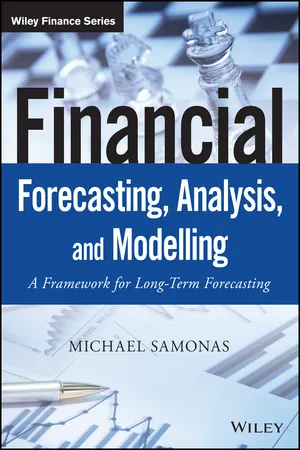
Financial Forecasting, Analysis, and Modelling
A Framework for Long-Term Forecasting
- English
- ePUB (mobile friendly)
- Available on iOS & Android
About This Book
Risk analysis has become critical to modern financial planning
Financial Forecasting, Analysis and Modelling provides a complete framework of long-term financial forecasts in a practical and accessible way, helping finance professionals include uncertainty in their planning and budgeting process. With thorough coverage of financial statement simulation models and clear, concise implementation instruction, this book guides readers step-by-step through the entire projection plan development process. Readers learn the tools, techniques, and special considerations that increase accuracy and smooth the workflow, and develop a more robust analysis process that improves financial strategy. The companion website provides a complete operational model that can be customised to develop financial projections or a range of other key financial measures, giving readers an immediately-applicable tool to facilitate effective decision-making.
In the aftermath of the recent financial crisis, the need for experienced financial modelling professionals has steadily increased as organisations rush to adjust to economic volatility and uncertainty. This book provides the deeper level of understanding needed to develop stronger financial planning, with techniques tailored to real-life situations.
- Develop long-term projection plans using Excel
- Use appropriate models to develop a more proactive strategy
- Apply risk and uncertainty projections more accurately
- Master the Excel Scenario Manager, Sensitivity Analysis, Monte Carlo Simulation, and more
Risk plays a larger role in financial planning than ever before, and possible outcomes must be measured before decisions are made. Uncertainty has become a critical component in financial planning, and accuracy demands it be used appropriately. With special focus on uncertainty in modelling and planning, Financial Forecasting, Analysis and Modelling is a comprehensive guide to the mechanics of modern finance.
Frequently asked questions
Part One
Developing Corporate Finance Models
Chapter 1
Introduction
1.1 WHAT IS FINANCIAL MODELLING?
- Reported financials for past years are the basis for most projection models. To forecast financial statements we make use of key performance drivers derived from historical records.
- Projecting future years for the 3 main financial statements – the income statement, the balance sheet, and the cash flow statement – is typically the first step. Income statement estimates for EBITDA and interest expense as well as balance sheet leverage statistics such as debt/equity and interest coverage are often the most important model outputs.
- Incorporating financial statement analysis through the use of ratios. More often profitability, liquidity, and solvency ratios are calculated in order to pinpoint any weaknesses in the financial position of a company.
- Performing valuation. Valuation involves estimating the value of a company using various techniques although the most commonly used are comparable company multiples and discounted cash-flow modelling.
- Conducting various forms of sensitivity analysis after a forecast model has been built. These analyses are often the real reason a model was built in the first place. For example, sensitivity analysis might be used to measure the impact on one model output – say free cash flow – from the changes of one or more model inputs, say revenue growth or the company's working capital needs (“What happens to free cash flow if we increase sales growth by an extra 2% next year and at the same time reduce the payment terms to the suppliers by 5 days?”).
Table of contents
- Cover
- Title Page
- Copyright
- Dedication
- Preface
- Acknowledgments
- About the Author
- Part One: Developing Corporate Finance Models
- Part Two: Planning for Uncertainty
- Appendix
- Index
- End User License Agreement